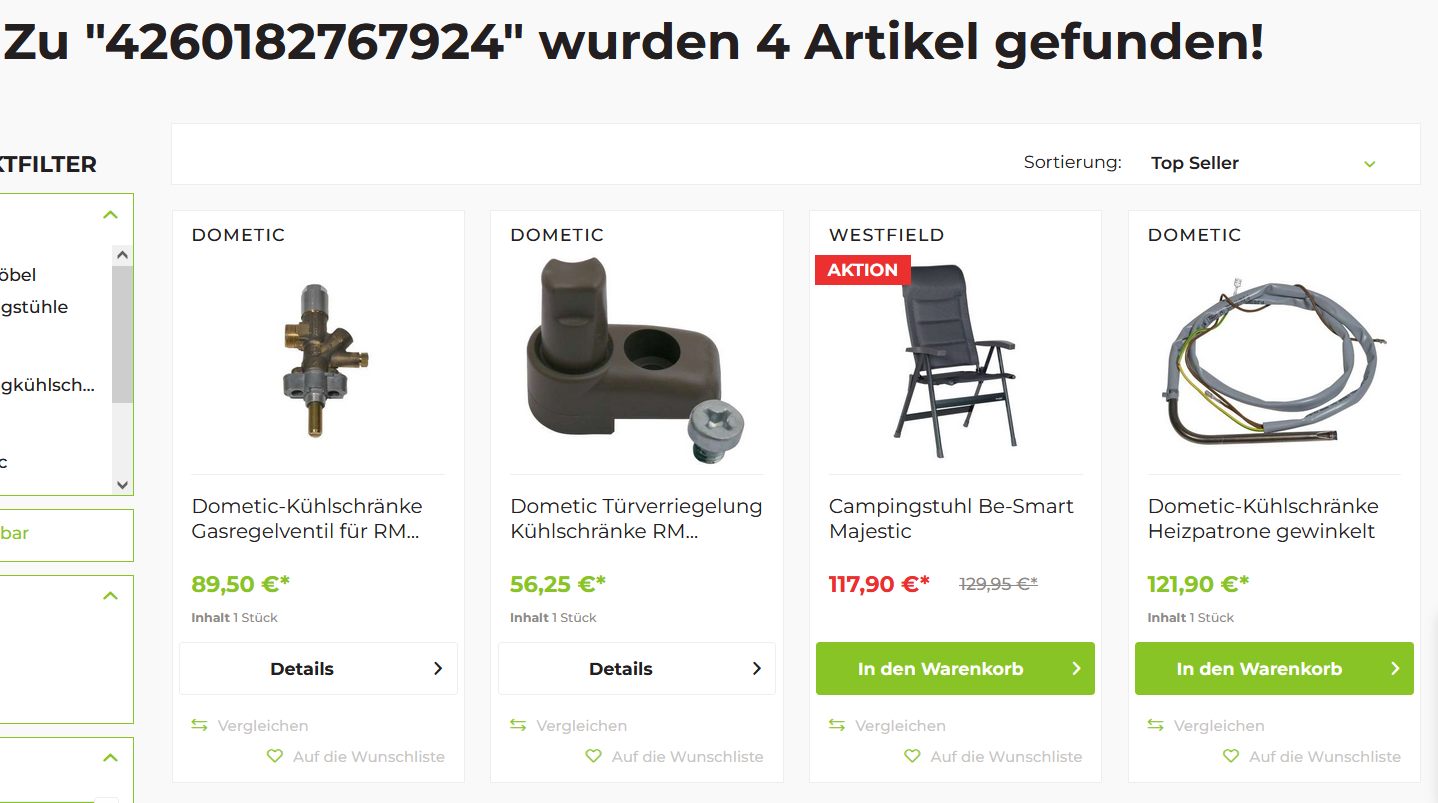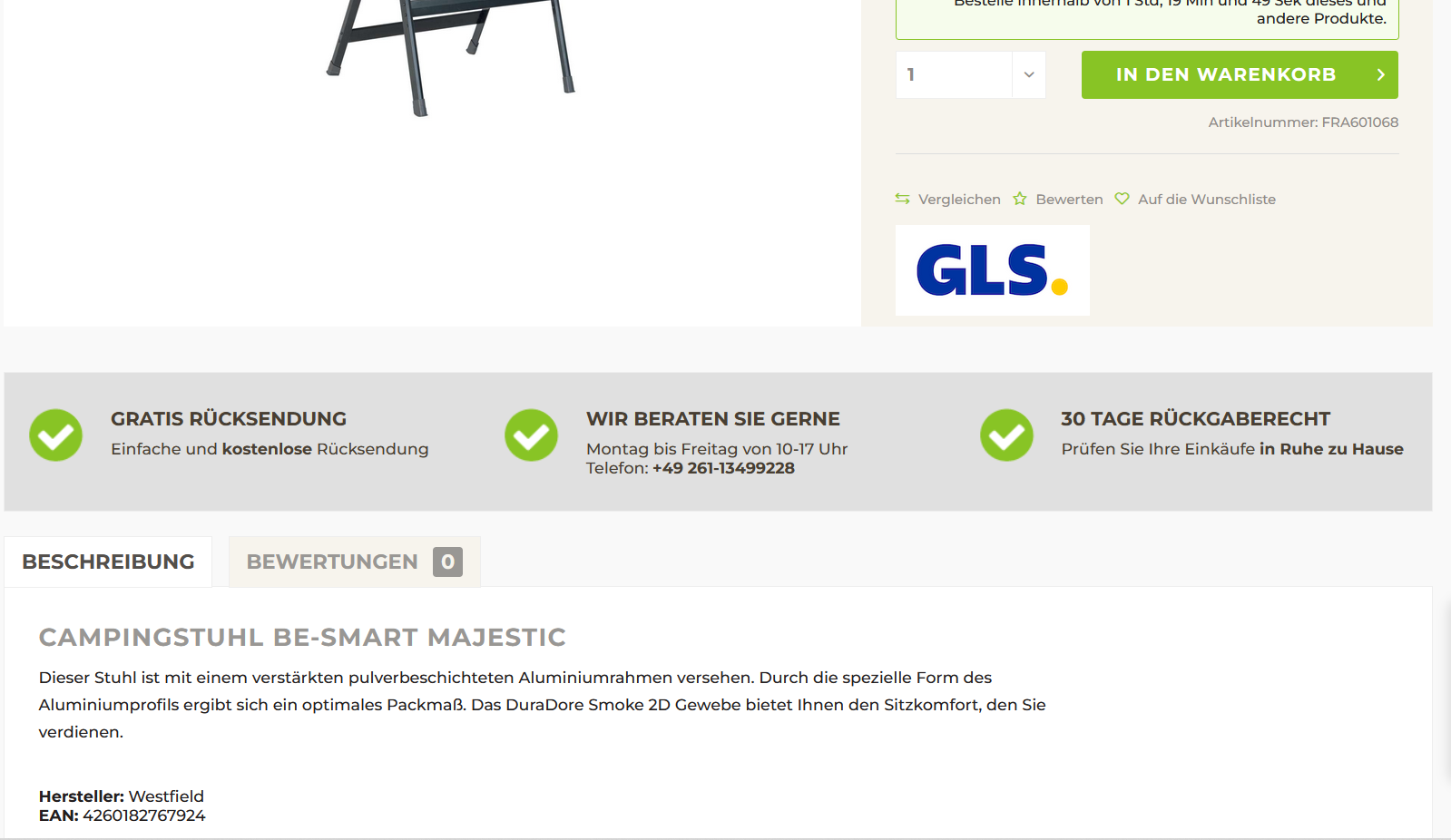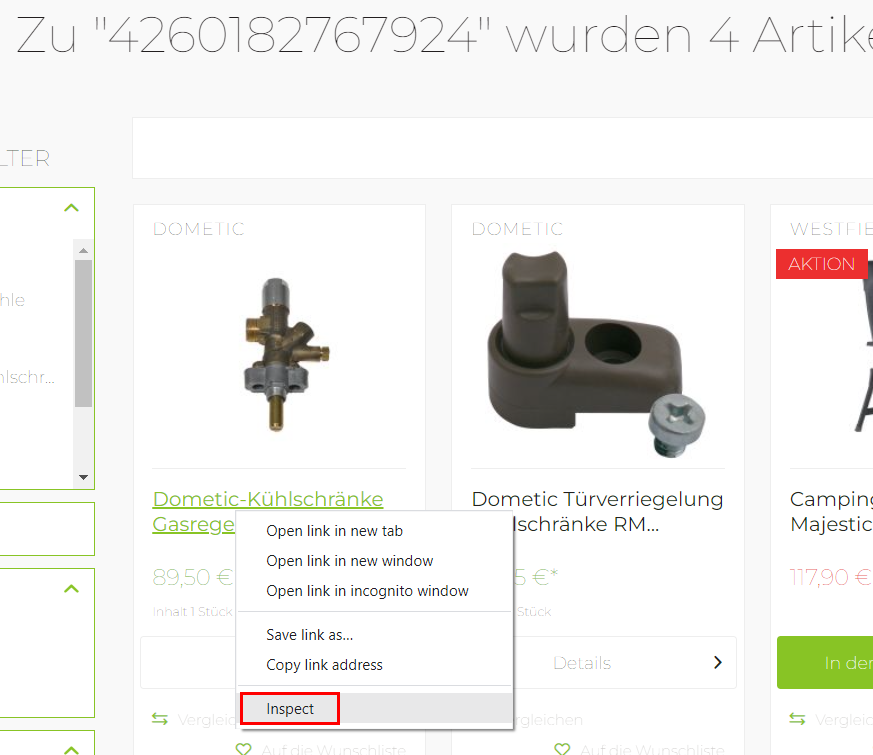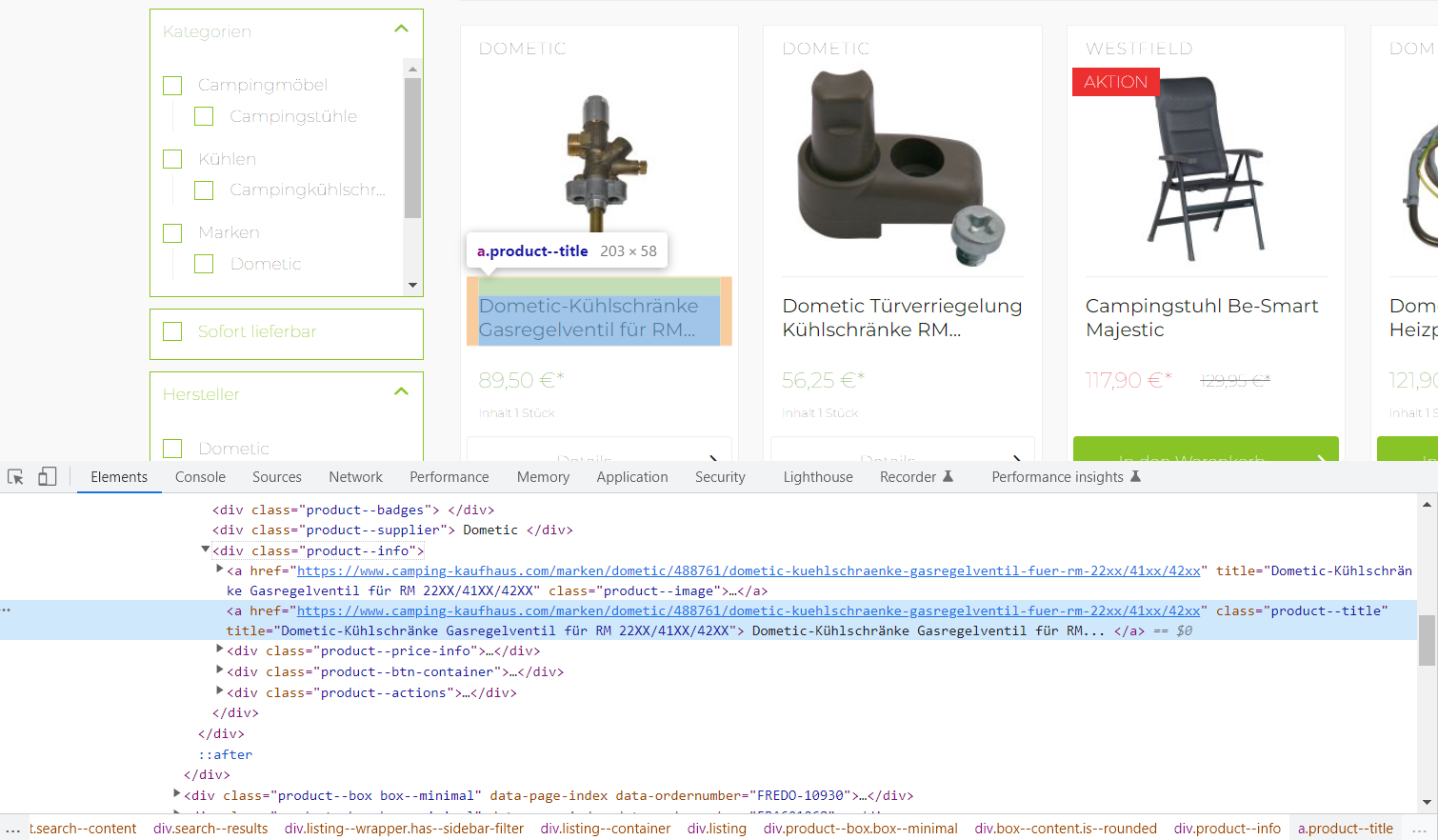Using REST API Calls on Public Websites

Introduction
Using API calls on public websites is a great alternative to UI automation. It’s a lot faster and more reliable. Though it is not always possible, so you won’t be replacing all your UI interactions with API call from now on. I’m assuming here you are already familiar with concept of APIs and also are familiar with consuming data in XML/HTML format.
This post is a response to a problem presented on I Love Automation server by a member Dion. Though REST API approach is not the only way to implement this, I think we can use Dion’s case as a sort of playground for showing differences between UI approach and API approach.
The Problem
When searching on Camping-Kaufhaus.com for a specific product with unique identifier called EAN we are getting multiple results.

The problem is: which one is the proper product which has EAN we are looking for? When clicking on link of each result we can examine EAN number on product page. So we can find out that our product is the chair.

High Level Solution
There is quite simple solution to it, but still I would like to write it down so it’s clear what do we want to do.
- Execute search with given EAN
- For each search result 2.1. Got to link from results page 2.2. Search for EAN on product page 2.3. If EAN on product page matches the one we’ve given initially save product’s URL
- Return product’s URL or empty string if not found
Now let’s see how we can implement this with each approach.
Examining Source Code
There is one potential blocker for API approach - if we don’t find data we’re looking for in source code then API approach is not possible. So let’s see if it’s not the case here. Let’s first examine search results page found under URL https://www.camping-kaufhaus.com/search?sSearch=4260182767924 (we’re using EAN from original question - 4260182767924). Now we’re gonna right click on one of link in results and select Inspect.

Now we should see Elements tab containing page source code, with one of a elements highlighted.

We can see that there is not one, but two a elements inside div of product--info class. Retrieving either of those href attributes will give us URL of each product.
<div class="product--info">
<a href="https://www.camping-kaufhaus.com/marken/dometic/488761/dometic-kuehlschraenke-gasregelventil-fuer-rm-22xx/41xx/42xx" title="Dometic-Kühlschränke Gasregelventil für RM 22XX/41XX/42XX" class="product--image">
<span class="image--element">
<span class="image--media">
<img srcset="https://www.camping-kaufhaus.com/media/image/d6/69/f3/5ddb692f973051158f2a6bc68fb21c9f9902adf5_DO11220_00_H_21_FRE_thumbnail_2000px_72ppi_200x200.jpg, https://www.camping-kaufhaus.com/media/image/92/79/b2/5ddb692f973051158f2a6bc68fb21c9f9902adf5_DO11220_00_H_21_FRE_thumbnail_2000px_72ppi_200x200@2x.jpg 2x" alt="Dometic-Kühlschränke Gasregelventil für RM 22XX/41XX/42XX" title="Dometic-Kühlschränke Gasregelventil für RM 22XX/41XX/42XX">
</span>
</span>
</a>
<a href="https://www.camping-kaufhaus.com/marken/dometic/488761/dometic-kuehlschraenke-gasregelventil-fuer-rm-22xx/41xx/42xx" class="product--title" title="Dometic-Kühlschränke Gasregelventil für RM 22XX/41XX/42XX">
Dometic-Kühlschränke Gasregelventil für RM...
</a>
(...)
</div>
When we do it for the remaining products we can see the same structure. That confirm that we should be able to retrieve URLs of product pages so we can navigate to each product page - required for step 2.1 of our high level solution. Now let’s see if we can extract EAN number from product page. Let’s open URL of first product https://www.camping-kaufhaus.com/marken/dometic/488761/dometic-kuehlschraenke-gasregelventil-fuer-rm-22xx/41xx/42xx. We could look for EAN field and use the same method as before - right click on EAN number and select Inspect. It will reveal that there is span element containing our number. That’s perfect!
<span class="ean--value">7332464190854</span>
Repeating this for remaining products shows that span element with the same class is also present on other product pages. So we just found out that we can also extract EAN number from product pages as described in requirement 2.2.
UiPath Approach
Now let’s demonstrate how to use API approach in UiPath. First we’re going to create new blank process with VBNet as expression language. We’re gonna add new library by pressing Manage Packages or CTRL + P. Search for UiPath.WebAPI.Activities, press Install and Save. Then add HTTP Request as a first activity, HTTP Request Wizard window will open, close it by clicking OK for now. Before we fill in required properties let’s add in_EAN as input argument for Main workflow and add "4260182767924" as default value. Let’s add variable called URL and set default value to https://www.camping-kaufhaus.com/search?sSearch=. Now let’s go back to our HTTP Request activity and set following properties in Properties tab:
Request URLasURL + in_EANResponse Content- hit CTRL + K and typeresponseContentas new variable nameResopnse Status- hit CTRL + K and typeresponseStatusas new variable name

All right, now we can test our workflow, just add one more Write Text File activity in the end, set responseContent as Text property and "response.txt" as FileName. It contains nothing else that website’s source code! We can find product--info class that we found in previous chapter, that contained information about search results along with their URLs. Now the next step for us is to extract all these URLs of products. How do we do that?
Extracting URLs from Search Results
We have our source code containing URLs of product pages (marked as 1. in our High Level Solution steps). Now we can contiue using at least two methods - string manipulation or parsing HTML/XPath. Each of them has its pros and cons, only the latter is proper one. We will continue with parsing HTML/XPath for now. Let’s just look at extracted HTML code and focus on part that will give us what we need:
<div class="product--info">
<a href="https://www.camping-kaufhaus.com/marken/dometic/488761/dometic-kuehlschraenke-gasregelventil-fuer-rm-22xx/41xx/42xx" title="Dometic-Kühlschränke Gasregelventil für RM 22XX/41XX/42XX" class="product--image">
<span class="image--element">
<span class="image--media">
We can notice that our product URL is a first child element of type a of div element that has class product--info. We can use following XPath to select all such elements: //div[@class='product--info']/a[1]. What’s left is to convert received data from string format to something that we can use XPath on. In .Net, HtmlAgility.HtmlDocument is such format. We only need to browse packages and search for HtmlAgilityPack by ZZZ Projects and others. After that let’s add following activites: Invoke Method, Assign and For Each loop. Create new variable named responseHTML of HtmlDocument type and set following expression as default value: new HtmlDocument().
Set these properties to Invoke Method:
- TargetType:
(null) - TargetObject:
responseHTML - MethodName:
LoadHtmlAnd in Parameters please add one parameter of DirectionIn, TypeStringand ValueresponseContent. This activity will load string from our response and allow us to retrieve html nodes from deserialized string.
For Assign activity please create new variable of type Array of HtmlAgility.HtmlNode called hyperlinks. Then assign following value to it: responseHTML.DocumentNode.SelectNodes("//div[@class='product--info']/a[1]").ToArray(). This will result in getting all hyperlink nodes, i.e. a elements.
And let’s put hyperlinks in List of items property of For Each, Type Argument should change to HtmlAgilityPack.HtmlNode. Now put Write Line inside and inside it put expression link.Attributes("href").Value. We can run our workflow to see if we’re going to get 4 hyperlinks we expect.

https://www.camping-kaufhaus.com/marken/dometic/488761/dometic-kuehlschraenke-gasregelventil-fuer-rm-22xx/41xx/42xx
https://www.camping-kaufhaus.com/marken/dometic/488796/dometic-tuerverriegelung-kuehlschraenke-rm-42xx/43xx/44xx
https://www.camping-kaufhaus.com/campingmoebel/campingstuehle/klappstuehle/492061/campingstuhl-be-smart-majestic
https://www.camping-kaufhaus.com/marken/dometic/488649/dometic-kuehlschraenke-heizpatrone-gewinkelt-125-watt/235-volt
These are exactly the links we got for our products.
Summary
If you would like to continue implementing remaining steps then you can use the same approach as I’ve just presented. Inside For each loop we can make another HTTP Request which can be followed by the same sequence of activities that resulted in producing above four links. The only difference would be that we want now EAN number. Feel free to prepare XPath that will select proper node with EAN number and post it in the comments.
I hope that you could understand how powerful this technique is. I will follow this up with another article where I will present UI approach and later we will compare these two methods in terms of performance. I hope to see you soon!
